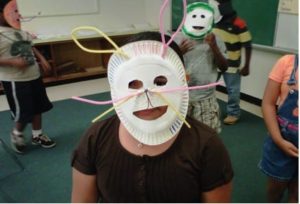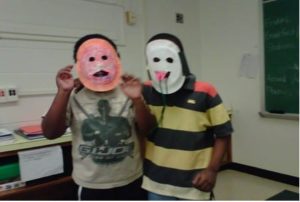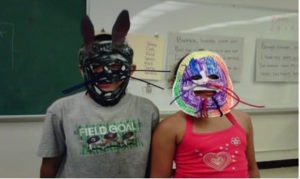By Nora Achrati
At Broad Acres, the kids rotate activities every six days according to age group. They’ve been divided into three classes each of 4th & 5th-graders, 2nd & 3rd-graders, and kindergarten & 1st-graders. I started out with the 4th & 5th-graders, who are fantastic. These kids threw themselves into our stories improv games, and really impressed me with the level of respect and empathy they carried for each other.
It was bittersweet having to give them up in the middle of Week 2 – they’d done some really stellar work with the Zomo story, inventing and illustrating new paths for Zomo to take in his quest for the scales of Big Fish, the milk of Wild Cow, and the tooth of Leopard. We’re excited to be able to donate these different Zomo stories to the community.
Wednesday I was introduced to the 2nd and 3rd-graders for the first time, which meant starting again from scratch. These kids are much more rambunctious, harder to settle, so we’ve had to re-emphasize the character pillars and class rules each day. And we’ve been experimenting with compromises – setting up a “wiggle area” where kids who find it harder to sit still can be for a while (individually, and quietly), and balancing on-the-floor acting activities with hands-on, sit-down activities. I’ve had to adapt my lessons, too – my second class of the day rebelled against Strega Nona (too many of them had read it before and wanted something new), so Thursday we read and performed “Manana Iguana” together, and Friday we spent making masks to represent the different animal characters:



Based on the success of the masks, though, I think I’ll be introducing “Manana Iguana” to the other classes before our time is up. The kids in the second class seemed to appreciate how much Spanish was incorporated into the story – for many, Spanish is a primary language at home – and enjoyed translating for me the days of the week and their own words for “party.” They’ve also been excellent at identifying the “Little Red Hen” themes of the story, and applying the character pillars.
This program is part of the Summer ELO-CARE program offered to select students in Montgomery County Pubic Schools. This is the ninth year that AHCMC has had the privilege to work with MCPS on this very worthy program. ELO-CARE is made possible by a grant from the 21st Century Community Learning Centers Program and the Maryland State Department of Education.
